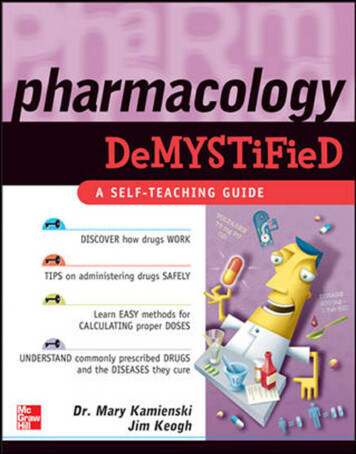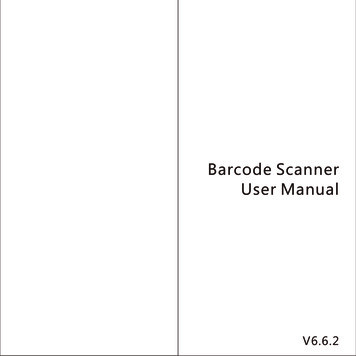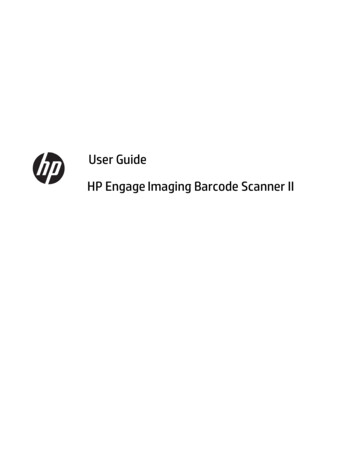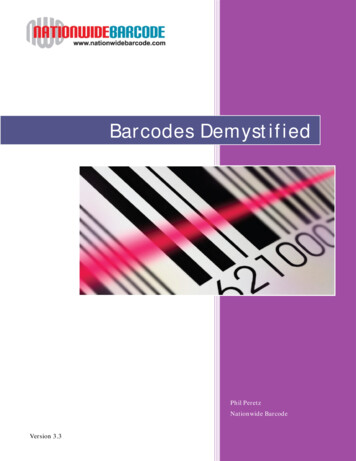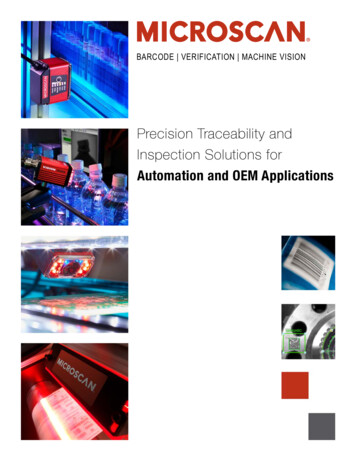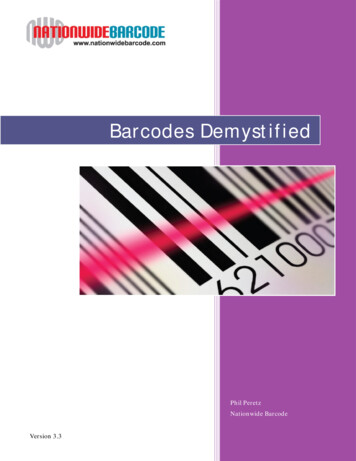
Transcription
Barcodes DemystifiedPhil PeretzNationwide BarcodeVersion 3.3
Table of ContentsForward . 4Why do I need a barcode? . 4Introduction to Barcodes . 6Are the U.P.C. and EAN-13 the same symbol? . 9The origin of EAN vs. U.P.C. confusion. (by George Laurer) . 11Anatomy of a Barcode.13The Check Digit .14Barcode Sizes .16Country Codes . 17What is a coupon code? .19Barcodes for Greeting Cards . 20Barcodes for Music .21Barcodes for Books . 22Barcodes for Magazines. 23Shipping Container Barcodes . 24UPC Databases . 25Barcodes and your Cell Phone . 26Are Barcodes the “Mark of the Beast”? . 27QR Codes . 28Q&A . 29What is the difference between SKU, UPC, EAN, Barcode, GTIN, GTIN-12 and GTIN-14 . 29What is a barcode? . 29How does a barcode work? . 29What information is in a barcode? . 29How many Bar Codes do I need? . 29What countries will UPC barcodes work in? . 30What’s the difference between a UPC and a UPC barcode? . 30What's a symbology? . 30How accurate is a Barcode? . 30Is there data encrypted within a barcode? . 30What size does the barcode need to be? . 30Should I reuse a barcode number? . 30Page 2
Glossary .31A .31B . 32C . 33D . 34E . 35F . 36G . 37H. 38I . 39J . 40K .41L . 42M . 43N . 44O . 45P . 46Q . 47R . 48S. 49T . 50U . 51V . 52W . 53X . 54Y . 55Z . 56Page 3
ForwardThe world of UPC barcodes can be daunting and confusing. The purpose of this book is to help youbetter understand how barcodes work.About the author:Phil Peretz is the President/COO and founder of Nationwide Barcode, a barcode solutions providerfor individuals and companies that need a fast, legal and efficient way of getting UPC and EANbarcodes.His professional career starting in advertising as classified advertising manager for a series of weeklynewspapers. At 21, he was hired as an art director for Diablo Valley Publishing, at 25, retailoperations manager and then found his passion as a sales manager and VP of sales in both theprinting and high tech industries focusing on building strong and successful sales teams.9 years of his career was with Kinko’s where he started off as a corporate account managershattering all existing sales records and went on to be promoted to Regional Sales Manager, Directorof Sales and then Regional Sales VP.Peretz then moved into the high tech sector as Director of Sales for an optical media manufacturingcompany and his own company, CDDVD Now. After selling off his company, Peretz moved to RenoNevada where he and his wife, Catherine Young-Peretz, founded Media Media Inc.In addition to running Nationwide Barcode, Peretz and Media Media Inc. works with businesses of allsize to helping them develop innovative ways of communicating, marketing and building profitablesales.Nationwide Barcode: http://www.nationwidebarcode.comMedia Media Inc.: http://www.mediamediainc.comUPCBarcodes.com: http://www.upcbarcodes.comDynamic Qr Codes: http://www.mmisscan.com 2013 – Phil Peretz, Media Media Inc.Why do I need a barcode?Page 4
You’ve manufactured or ordered your products and you realize that you need a barcode. Barcodesare used to convey prices to the electronic cash registers in stores and are also used to help manageinventory. You will need a barcode for each product or variation of product that you sell. If you areselling t-shirts, you will need one for each design, color and size. You either add the barcode graphicto you artwork while designing your packaging artwork or you order barcode labels and affix a label toeach one of the packages. You are ready for business and you have everything you need to startselling your products to stores.The stores place an order with you and you provide them with a product specification sheet – this is alist of your products, product details and the UPC or EAN barcode for each item. Every storemaintains their own database of products and barcode numbers. There is no database that containsall products everywhere. There is nothing embedded in a UPC or EAN barcode except for the numbers that are beneaththe barcode. When they enter the info into their database, the numbers are associated withyour product. When a barcode scanner scans the barcode, it turns the bars back into numbersand looks for the item associated with it. There are a number of ways that you can communicate this information to the retailers, yourretailer will let you know how they want the information. Sometimes they will ask for a printedsheet with a list of your items, sometimes they will want an excel spreadsheet that they canupload to their database. This all depends on the number of items and their level of technicalrequirements. The information that you have supplied gets entered into the computer that connects all of theirPOS systems (electronic cash registers). All of this is done at store level because there is noaccurate and complete database of products, and if there was, it could potentially carry billionsof items. That’s too much data for local stores to access, so, all stores only concernthemselves with their inventory. Your products are delivered to the retailer and once received into inventory and are nowavailable for purchase. Sometimes your retailers will ask you to add an additional barcode to the outside carton. Theywill refer to this as a Shipping Container Barcode or a GTIN-14. We can provide those too. A customer picks up the item to be purchased and heads to the check-stand. The item is scanned and the point of sale system (cash register) requests information aboutthe product from the database. Once purchased, the Point of Sales system tells the databaseto subtract the number of items purchased. The customer pays for the item and the transaction is complete.Page 5
Introduction to BarcodesWherever you go, the grocery store, department store, on line at Amazon or your own refrigerator orpantry, you’ll find that everything that you purchase has a UPC barcode on it. Sometimes they are alittle hard to find, but if you flip the package around, it’s there.In this book, we will demystify UPC and EAN barcodes so that you have a better understanding ofhow they work.A barcode is an optical machine-readable representation of data. One of the first uses of barcodeswas to label railroad cars, but they were not commercially successful until they were used toautomate supermarket checkout systems, a task in which they have become almost universal.Systems such as RFID are attempting to change the standard, but the simplicity, universality and lowcost of printed barcodes has limited the role of these other systems. It costs less than one-half of onecent to implement a printed barcode compared to seven to thirty cents to implement a passive RFID.*George Joseph Laurer developed the Universal Product Code in 1973. As an engineer at IBM he wasasked to develop the pattern used for the Universal Product Code (UPC-A Barcode).GS1, which used to be called the Uniform Code Council (UCC) is the provider of UPC barcodeprefixes. A company goes to the GS1, they purchase the prefix and then are responsible for the selfassignment of the identification numbers that go after the prefix.The Barcode prefix, the first 6, 7, 8 or 9 digits, is called a UPC Barcode Prefix The company who hasbeen assigned the UPC Barcode Prefix is responsible for the assignment of the next digits (makingup a total of eleven digits) to their products.Then, as the barcode number is designated, the last number is mathematically determined throughan algebraic equation to create a checksum (check digit). This check digit is the final digit. When youjoin GS1, you get a prefix certificate along with your start-up package.As far as we know, there are only a small handful of companies that require a copy of this certificate:Kroger’s, Wal-Mart/Sam’s Club JC Penny’s and Macy’s. The common denominator of thesecompanies is that they are using the manufacturer prefix for their EDI (Electronic Data Interchange).Since this is how they make sure their vendors get paid.Unless you are specifically going to do business with these chains, you have the option of using acompany that is legally able to subdivide their barcode prefix.The GS1 maintains the database of Prefixes. It is our opinion that, although this database isconceptually a great idea, and has to be maintained, it is virtually ignored, unknown and unused.Retailers input information from product data sheets filled out or given to them by their suppliers. Thesupplier gives the retailer the product information including the barcode based on the human readablenumbers (12 digit UPC or 13 digit EAN) and the retailer enters it into their point of sale system.Page 6
There are no unified and formal centralized databases of product barcodes. Using the mathematicalformula x 12x10 there are potentially 10 billion products that can be represented by UPC-A barcodesat any given time – 100 billion if you take add the extra digit on an EAN.This, more than anything else, explains why there is no centralized database of products. No one hasthe bandwidth, energy or resources to catalog something this massive.There is nothing programmed into a UPC or an EAN barcode. The bars only represent the numberthat is the barcode. The retailer associates these numbers with the product information. Thisinformation is pulled from the retailer’s database when a product is scanned.You have two choices when you need to buy a barcode or block of barcodes. You purchase directlyfrom the GS1 (They charge a minimum of 750.00 plus a yearly renewal fee) or you purchase fromus or a company like Nationwide Barcode (www.nationwidebarcode.com). Nationwide Barcode andsimilar companies received their prefixes in the 90’s or early 2000’sIn 2002 GS1 attempted to codify the agreement with UPC Barcode prefix holders which includedrenewal fees. The codified agreement included rules that were in the form of a contract whichincluded not being able to subdivide a barcode number. Prior to this, none of this existed.The GS1 decided to change the way they were doing business. They started sending out renewalnotices insisting that the prefix holders pay renewal fees and agree to the new terms and conditions.Ultimately a class action suit was levied against the GS1 in the state of Washington and the GS1 lost.All prefix owners prior to August 28, 2002 became exempt to the GS1’s renewal fees and newcodified agreement.Quoting the UCC Settlement web site:This Settlement provides that companies who became members of UCC before August 28,2002, are not obligated to pay membership renewal fees to UCC to maintain membership as acondition for their use of Company Prefixes issued to them by UCC, or as a condition for BasicMembership Benefits as defined in the Class Settlement Agreement. Class members whohave paid a renewal fee to UCC are entitled to compensation from a 3,895,000 settlementfund. The settlement also provides that the "licensing agreement," which accompanied UCCrenewal fee invoices, is null and void as to those who became members in UCC before August28, 2002. **Quoting George Laurer, “Often I am asked if a person that purchases a number from a subset sellerwill have legal problems in the future. Again, I am not a lawyer, but if the number was originallyassigned to the seller by the UCC before August 2002, the answer is no problem.”****The decision to go with the GS1 or a UPC barcode reseller is a matter of economies of scale. GS1charges an upfront fee and a yearly renewal fee based upon the number barcode numbers that youneed along with your company’s revenue. The more you make, the more the barcode prefix will costyou, and this amount can increase over time.Page 7
We believe that the GS1 is a great organization, they provide a tremendous service, however, for asmall business with a limited budget, a Barcode Subdividing company makes the most sense.* Text provided by Wikipedia and is available under the Creative Commons Attribution/Share-AlikeLicense. http://en.wikipedia.org/wiki/Barcode ** http://www.ibcaweb.org/ucc-settlement.htm e.html (page on George Laurer’s website) ****http://www.laurerupc.com (George Laurer’s site)Page 8
Are the U.P.C. and EAN-13 the same symbol?The short answer is yes.EAN 0012345678905UPC (0)012345678905 or 012345678905The GS1, the original source for barcodes has created the confusion between UPC (UniversalProduct Codes) and EAN (European Article Numbers also called International Article Numbers). TheUPC-A barcode was the original format for product barcodes. As demand in Europe, Asia andAustralia started growing, country codes were added. (We have a list of country codes in this book).US and Canada have a a country code of zero which is not printed under the barcode nor is it enteredin US and Canadian Inventory and Point of Sale Databases.If you look at the graphics below, you will see they are exactly the same. The width of the bars andthe width of the spaces between the bars are exactly the same. The only major difference is theplacement of the numbers below (human readable numbers) which are there only as a back-up incase the barcode doesn’t scan properly and the information has to be manually entered into the pointof sale systemWe have overlaid the UPC and theEAN graphics (symbologies) so youcan see that the graphic is identical.The country code doesn’t appearbeneath the barcode in a UPC sincethe GS1 didn’t grasp the importance ofUS and Canada indicating countrycodes. They felt that since the majorityof products sold in both countriesoriginate from importers, distributors ormanufacturers in the US or Canada,they could forego the leading zero inthe human readable numbers.We still believe that if you are currently doing business in the United States and Canada exclusively, itis safer to order UPC barcodes for your products. Many retailers, especially smaller retailers may beusing older accounting and inventory systems that only allow them to enter in 12 digit UPC numbersand not a 13 digit string. If this changes in the future, you can convert your 12 digit UPC to a 13 digitEAN by adding in the country code 0. There is nothing on the horizon indicating that the US andCanada will ever switch over to EAN 13 barcodes.This following information is used with permission from George Laurer– http://www.laurerupc.com .Mr. Laurer is the inventor of the UPC barcode.There seems to be considerable confusion concerning the difference and use of the U.P.C. code andEAN codesPage 9
"U.P.C. Version A" and "EAN-13” are and always have been 13 character symbols and the numbersthemselves have always been 13 characters long. The U.P.C. (Version A) symbol and the EAN13symbol are essentially one and the same. They both have the same number of bars and spaces.* I have used the name UCC throughout to avoid confusion although it evolved to this name over manyyears. In 1975 it was called UPCC (Uniform Product Code Council).Page 10
The origin of EAN vs. U.P.C. confusion. (by George Laurer)When I conceived the U.P.C. for the grocers in the U.S. only 12 digits were required including thecheck character. I designed a symbol in which the left half of the symbol was composed of “odd”parity characters and the right side was composed of “even” parity characters. Each printed characterhas two bars and two spaces and is made up of 7 modules. Odd parity simply means the printedrepresentation of the numeric digit has an odd number of dark modules. Conversely even parityprinted digits have an even number of dark modules.The UCC* chose to call the U.P.C. a 10 character symbol and they chose to print only 11 of thecharacters in human readable form. The 10 characters identifying the manufacturer and item wereprinted below the bars. The “system number” character was printed halfway up the left side. Further,they chose to carry only 10 digits of the number in their files. The reason was both political andpractical.Before the symbol marking was considered a well know consulting firm had been hired by thefledgling UCC to determine the number of digits needed to accomplish the goals of the groceryindustry. Considering many factors, not the least of which was the limited power of computers of theday, a figure of 10 digits was recommended. It was a tough sell to convince the many groups involvedthat they would have to change whatever numbering system they were using to the new 10 digitnumber. Rather than admit that the consulting firm was wrong and so as not to open the number ofdigit argument again, the decision was to maintain that the U.P.C. was a 10 digit symbol and number.Another factor considered was that it was more difficult to key the EAN human readable that theU.P.C. human readable when the symbol did not scan. They fostered the illusion by requiring that thecheck digit be stripped at the scanner. The SN (system number) was necessary for in storeprocessing but it was not needed in records transferred between systems. The illusion was reinforcedby not printing the SN in line with the 10 product identifying digits and not printing the check digit atall.After the U.P.C. had been in use several years, Europe recognized the usefulness of the U.P.C. butrealized a 13th digit was needed to identify the many countries. I encoded the extra digit by encodingthe left half of the symbol with 3 characters of even parity and 3 characters of odd parity and thenarranging them in various patterns, each pattern representing a different country code. The scannerrecognizes a series of digits as the right half of a symbol if the parity of the characters is all even andit recognizes the left half if it is composed of all odd OR if three characters are odd parity and threecharacters are even parity characters.With the acceptance of the EAN in Europe it was understood that the U.P.C. was actually 13 digitsbecause the parity pattern of the left half of all odd characters was assigned the value (or countryflag) of “0”. I pointed out that the UCC only printed 11 of the 13 digits and carried only 10 digits in thesystem. The UCC continued the delusion by using the foolish argument that "0" means nothing andtherefore could be ignored. On the other hand, the European's were smart enough from the veryoutset to call the EAN symbol what it is, “EAN-13” and they printed all 13 characters. Systems inEurope carried all 10 country flags including 0 in their records and their systems could process bothU.P.C. and EAN symbols and/or numbers. The U.S. groceries chains at the time were selling veryfew foreign goods and saw no reason to spend money modify their installed equipment. Although theU.P.C. was not widely accepted at that time, the UCC accommodated the foreign companies byissuing them U.P.C. numbers with the invisible country flag of “0”.Page 11
Although this was a burden on the European companies and was a waste of numbers since manyEuropean companies had both U.P.C. and EAN-13 numbers, it wasn’t until two decades later thatsomething was done about this. In 1997 the Uniform Code Council, Inc announced project SUNRISE.This initiative required that all U.S. and Canadian companies must be capable of scanning andprocessing EAN-13 symbols, in addition to U.P.C. symbols, at point-of-sale by January1, 2005. Thishas been completed, the UCC has changed its name to GS1 US, and they have taken theresponsibility of controlling both U.P.C. and EAN numbers.Simply put the U.P.C. and EAN-13 symbols and numbers are the same. Below is a U.P.C. symbolwith its equivalent EAN-13 superimposed in red. One can see that the bars and space are the same,only the human readable is different. Note that the U.P.C. has evolved in that the check digit is nowprinted and also that the SN has been brought down in line with the other characters but the countryflag is still not printed. I would expect that in the near future the human readable will also be changedto the EAN format.Because there are more than 9 countries, the country flags have been further subdivided by using thenext two digits for various uses and countries. The United States and Canada have the country flag 0and subdivisions 000 thru 139. It is interesting to note that the publishing industry produces so manyproducts that it is its own country called “Bookland” for number assignment purposes. Bookland hasbeen given two subdivisions of the country flag 9. They are 978 and 979.--end of article by George Laurer.Page 12
Anatomy of a BarcodeUPCEANThe barcode symbol has two parts:1) The machine-readable bar code (The bars)2) The human-readable number (the numbers below)In this picture, the manufacturer identification number is the first six digits of the UPC number –(0)753182 in the image above. The next five digits -- 95342 -- are the item number. The GS1supplies 7, 8 and 9 digit manufacturer numbers as well. The last number, 7, is the check digit.The person that coordinates which barcode goes with which product is called a UPC coordinator. Thisperson is responsible for assigning item numbers to products, making sure the same code is not usedon more than one product, retiring codes as products are removed from the product line, etc.Typically, every item that a manufacturer sells, in addition to every variation of the item requires adifferent item code. Since the barcode is also used to track inventory, it is important to have adifferent barcode for each of these variations. Using shoes as an example, a man’s oxford shoe maycome in Black, Brown, and Cordovan, each in sizes, 9, 10, 11, 12, 13 and 14. Each of thesevariations (3 colors x 6 sizes 18 different products)0:1:2:3:4:Standard UPC numberReservedRandom weight items (fruits, meat, vegetables, etc.PharmaceuticalsIn store marketing for retailers (a store can set up unique bar
us or a company like Nationwide Barcode (www.nationwidebarcode.com). Nationwide Barcode and similar companies received their prefixes in the 90's or early 2000's In 2002 GS1 attempted to codify the agreement with UPC Barcode prefix holders which included renewal fees.
